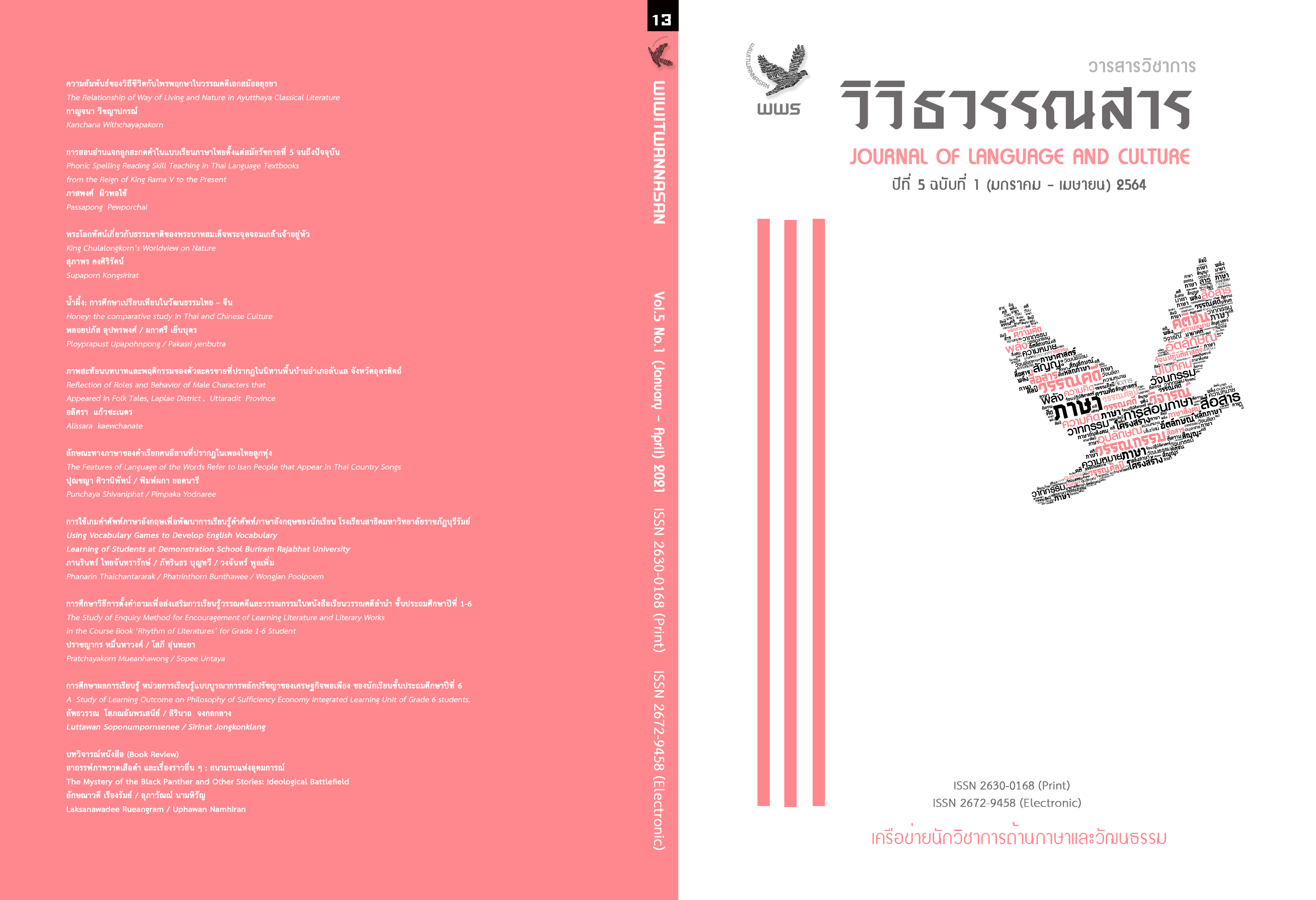The Relationship of Way of Living and Nature in Ayutthaya Classical Literature
Main Article Content
Abstract
The purpose of this research was to analyze the relationship between the way of living and nature in four Ayutthaya classical literatures: Mahachat Kham Luang, Lilit Phra Lo, Samutthakhot Khamchan, and Suea Kho Khamchan. The analysis showed that there were three types of relationship between nature and way of living. The first one was nature-human relationship, which consisted of two modes. The first mode was between nature and human appearance while the second mode was nature and human nature. The second type was nature-cultural context relationship. Here, it showed that nature performs an important role on human life; and that nature can represent the belief and value of human. Lastly, the third type was of nature-social context. Nature can represent the social status of a person. It emphasized how gender, as assigned by society, dictated the social status, social space, and sexuality of the individuals. Overall, the relationship between the way of living and nature in the four Ayutthaya classical literatures emphasized the interdependent relationship between nature and human. The being of human was conditioned by nature while nature can exist only through human consciousness and thought.
Article Details
Copyright is that of the journal any reproduction must be permitted by the editor of journal
References
Boonkachorn, T. (2010). Duoy saeng haeng wannakhade priepthep wannakhade priepthep:
krabuanthat lae withikan (in Thai) [In the Light of Comparative Literature
(Comparative Literature: Paradigms and Methods)]. (2nd ed.). Bangkok: Chulalongkorn
University.
Chitchamnong, D. (1989). Khunkha lae laksanaden khong wannakhadi thai samai
rattanakosin tontoan (in thai) [the literary Values and Characteristics of Early
Ratanakosin Literature]. Bangkok: Thammasat University.
Chitchamnong, D., Ruengruglikit, C. and Sujjapan, R. (1989). Thor mai nai sai nam: songroi
pe wanakhadewijanthai (in thai). [History of Thai Literary Criticism from 1782 to
1982]. Bangkok: Ponpankarnpim.
Fagan, Deirdre J. (2000). The nature of nature in the poetry of Hardy Dickinson and
Frost. D.A. Thesis. State University of New York. UMI 9977599.
Fine Arts Department. (1975). Jotmaihet phraratchaphitebarommaracchaphiset Somdet
Phraramathibordesrisunthornmahawachirawut phramonggutklawjawyuhua (in
Thai). [The coronation of king Rama VI]. (2nd ed.). Bangkok: Fine Arts Departmant.
Fine Arts Department. (1997). Wannakam samai ayutthaya lem nueng (in Thai) [Literature
of the Ayutthaya Period Vol 1]. (2nd ed.) Bangkok: Fine Arts Department.
Fine Arts Department. (2002a). Wannakam samai ayutthaya lem sam (in Thai) [Literature of
the Ayutthaya Period Vol 3]. (2nd ed.) Bangkok: Fine Arts Department.
Fine Arts Department. (2002b). Wannakam samai ayutthaya lem sam (in Thai) [Literature of
the Ayutthaya Period Vol 2]. (2nd ed.). Bangkok: Fine Arts Department.
Pattranukrom, P. (2006). Miti ying chai nai swatdikansungkhom (in Thai) [Gender in
SocialWelfare]. Bangkok: Krirk University.
Phra Brahmagunabhorn, P. (2008). Photchananukrom chabap pramuansap (in Thai)
[dictionary of Buddhism]. (11th ed.). Nakornprathom: Wat Yannawetsakawan.
Royal Institute. (2003). Photjananukrom chabapratchabandittayasathan phor sor song
pan ha roy sisipsong (in Thai) [Royal Institute Dictionary 1999]. Bangkok:
Nanmeebooks.
Sarttre, S. (1883). Wannakhade priepthep (in Thai) [Commparative literature]. Bongkok:
Thammasat University.
Shivasariyanada, W. (2001). Wannakhade lae wannakhadewijan (in Thai) [Literature and
Literary criticism]. (6th ed.). Bangkok: Thai Watana Panich., W. (2001). Wannakhade
Lae wannakhadewijan (in Thai) [Literature and literary criticism]. (6th ed.). Bangkok:
Thai Watana Panich.
Siripat, D. (2002). Tonmai baiya: chaba khwamngam lae khwammai neua hu (in Thai)
[Plants: the beauty and the meaning of putting Chinese rose behind 2 ears. Retrieved
fromhttps://www.doctor.or.th/article/details/2339.
Supap, S. (2002). Sungkhomwittaya (in Thai) [sociology]. (22nd ed.). Bangkok: Thai Watana
Panich.
Suwanwihok, K. (2015). The definition of water in the early rattanakosin tale literature
(Master’s thesis). Thammasat University, Pathumtani.
Vajirayana. (n.d.). Praratchaphithisipsong duean (in Thai) [Thai royal tradition in one year].
Retrieved from https://vajirayana.org.
Water Lily Museum. (nd.). Bua: khwamcheua (in Thai) [Water lily: belief]. Retrieved from
https://kaewsaensai.wordpress.com.
Wellek, R. & Warren, A. (1949). Theory of Literature. New York: Harcourt, Brace and Company.


